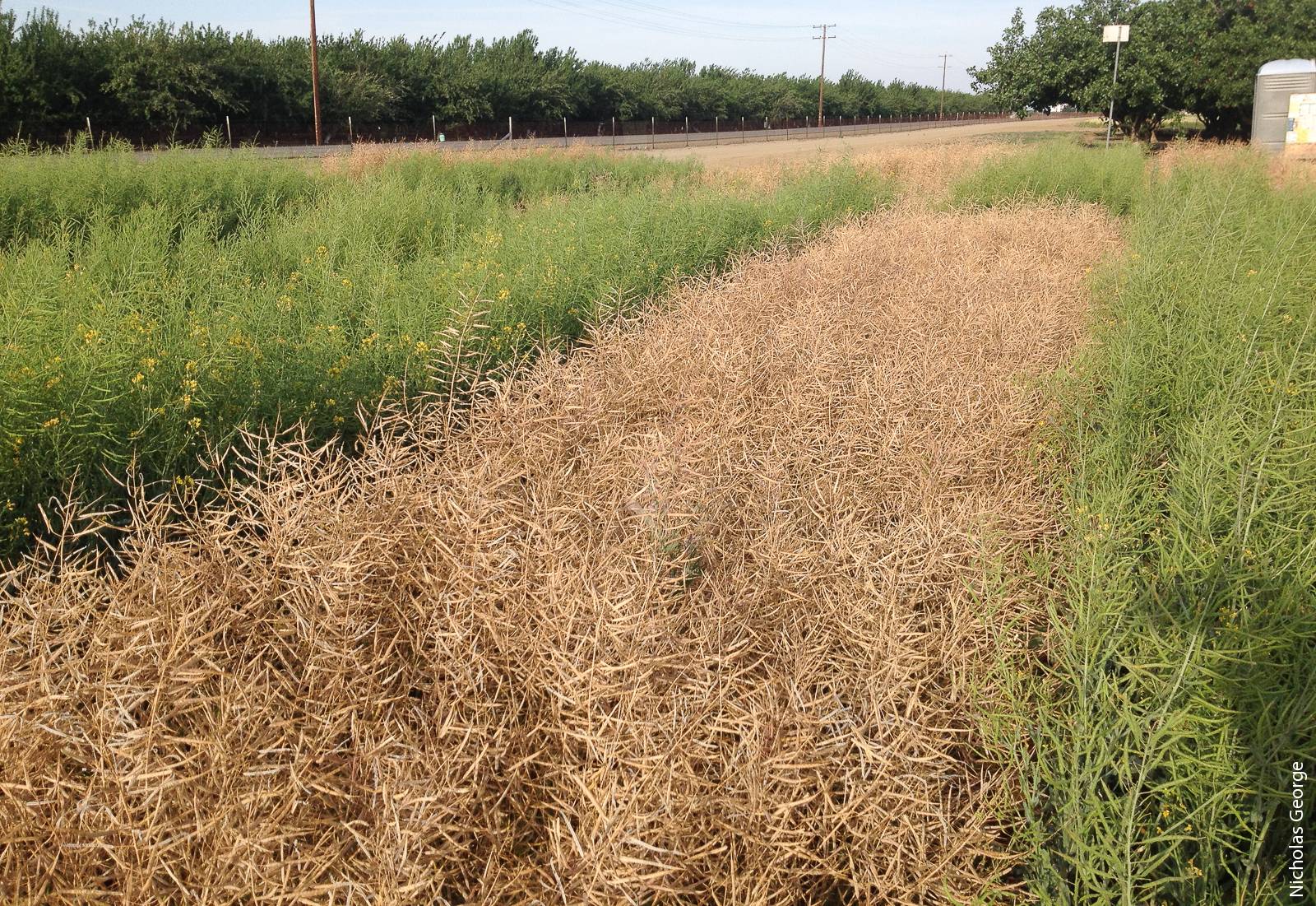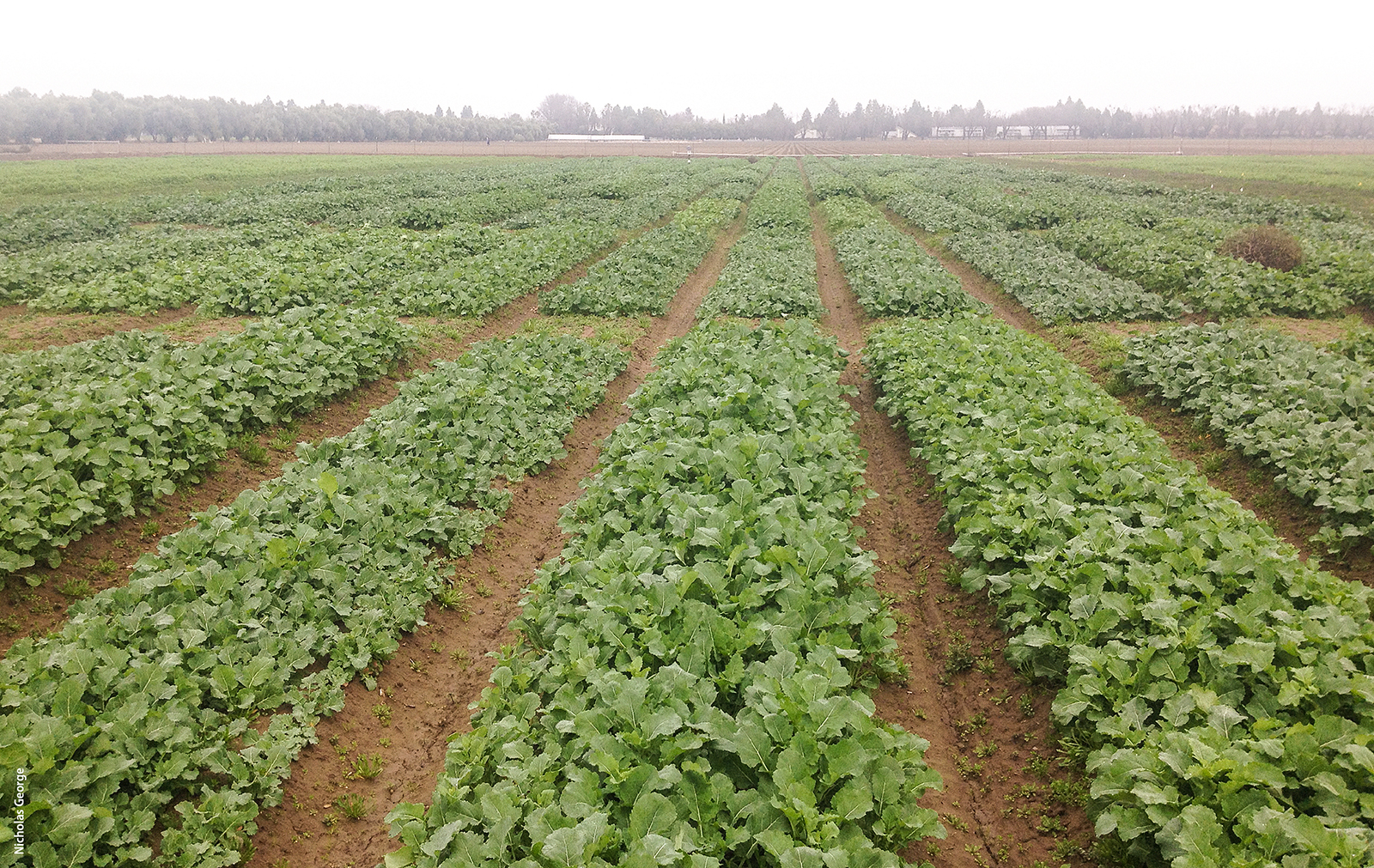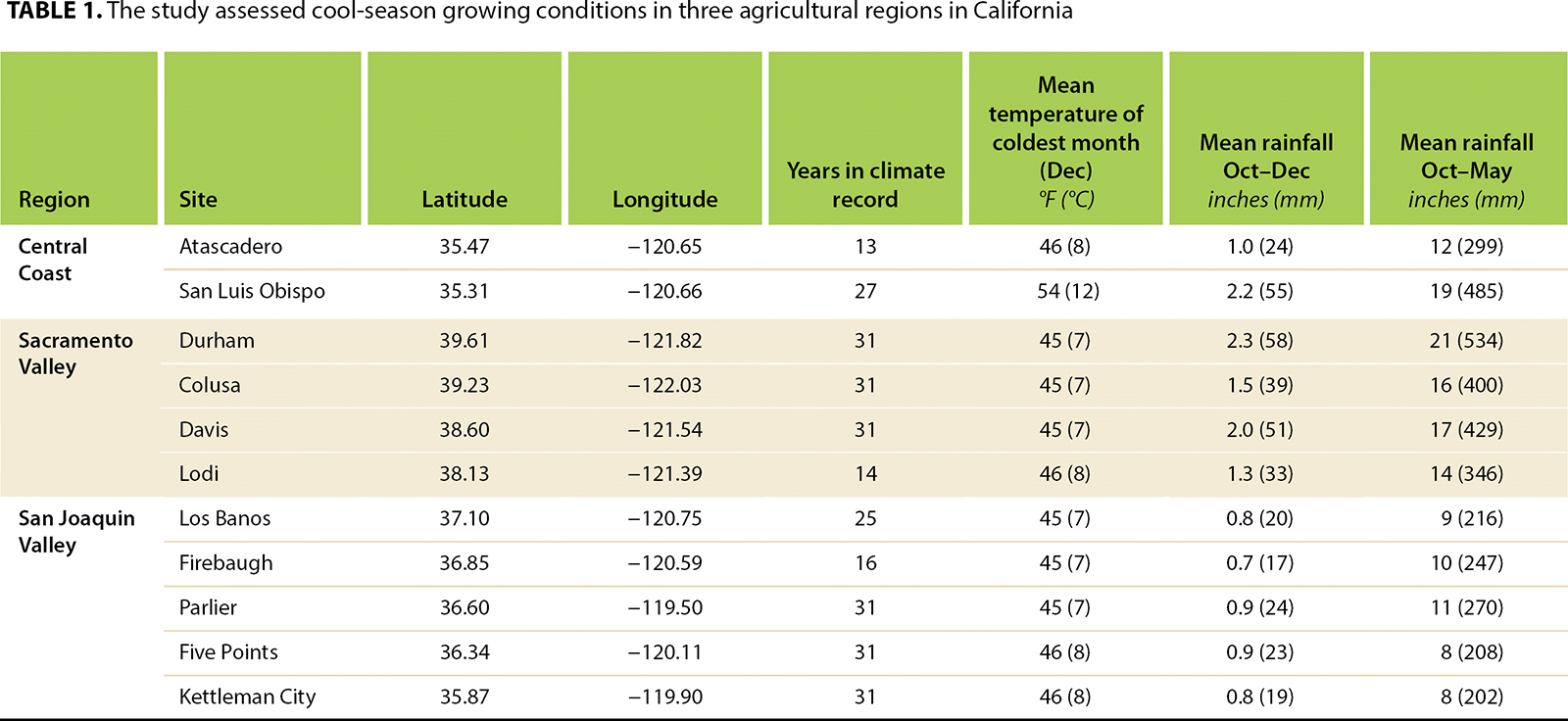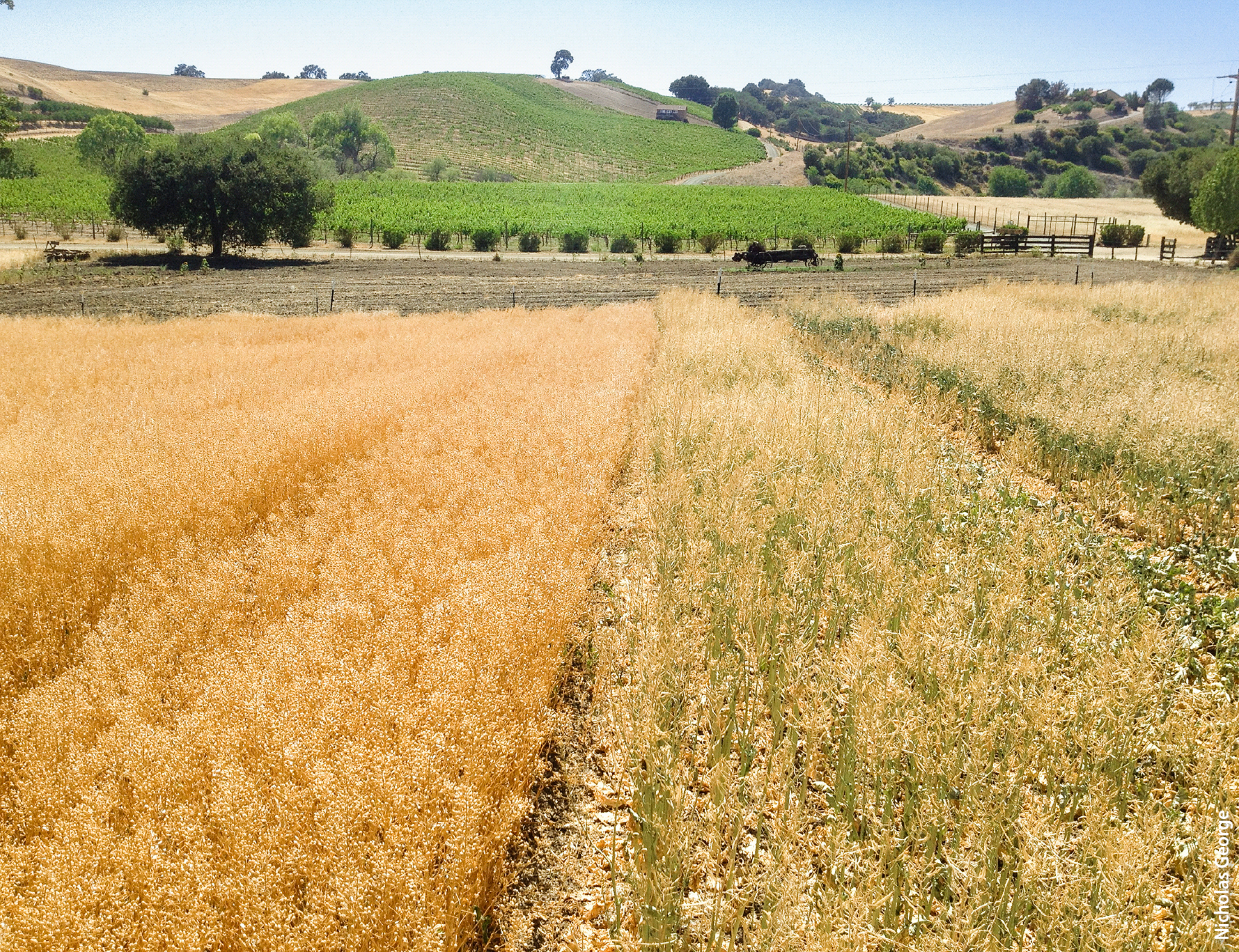All Issues
Modeling identifies optimal fall planting times and irrigation requirements for canola and camelina at locations across California
Publication Information
California Agriculture 71(4):214-220. https://doi.org/10.3733/ca.2017a0019
Published online June 06, 2017
NALT Keywords
Abstract
In California, Brassica oilseeds may be viable crops for growers to diversify their cool-season crop options, helping them adapt to projected climate change and irrigation water shortages. Field trials have found germination and establishment problems in some late-planted canola, but not camelina at the same locations. We used computer modeling to analyze fall seedbed conditions to better understand this phenomenon. We found seedbeds may be too dry, too cold, or both, to support germination of canola during late fall. Based on seedbed temperatures only, canola should be sown no later than the last week of November in the Central Valley. Camelina has broader temperature and moisture windows for germination and can be sown from October to December with less risk, but yields of camelina are lower than canola yields. In areas without irrigation, growers could plant canola opportunistically when seedbed conditions are favorable and use camelina as a fallback option.
Full text
Diversifying crops can improve farm economic performance, aid with weed and pest management, better utilize soil and water resources, and, in the case of Brassica oilseeds, provide benefits for pollinators. Growers have relatively few economically viable cool season crop options in California (USDA NASS 2012), but diversifying winter crop options may become more valuable if summer production of irrigated annual or short-term perennial species is limited by shortage of irrigation water, and potentially by climate change (Cayan et al. 2008; George and Kaffka 2017; Jackson et al. 2012).
On an area basis, wheat is the dominant cool-season crop in California (USDA NASS 2012, 2015). There has been long-standing interest in the potential of canola (Brassica napus), and other Brassica oilseed species, to diversify cereal-based cropping in California (Kaffka et al. 2015; Knowles et al. 1981). In a recent review, Angus et al. (2015) concluded that canola can have synergistic effects on the productivity of wheat-dominated cropping. It benefits subsequent wheat crops by acting as a disease break, suppressing weed growth and providing more flexibility in herbicide choices.
An early maturity variety of canola (center) grows next to late maturity varieties in a trial at the UC ANR West Side Research and Extension Center near Five Points. Using canola varieties that germinate reliably under either drier or colder soil conditions could potentially broaden the planting window and increase the number of years in which rain-fed production of canola is viable.
Canola seed is used for the production of edible oil and high protein oilseed meal used for livestock feed. It is also used for biodiesel production. At present, the demand for these products in the United States is larger than domestic production (FAOSTAT 2015; Johnson and Fritsche 2012; Newkirk 2009; USDA ERS 2014; USDA NASS 2015). Camelina (Camelina sativa) is another cool-season oilseed crop of interest to California growers. Currently, camelina is not widely used as a food for either humans or livestock, but it has been used for this in the past, and there is recent research directed towards this use (Betancor et al., 2015; Campbell et al., 2013; Cruz and Dierig 2015; Vollmann et al. 2007). At present, canola and camelina are not important crops in California. If used to diversify cool-season cropping, however, they could help sustain the long-term viability of California agriculture.
Under rain-fed production, the mean yield of canola in the Sacramento Valley (northern Central Valley) is predicted to be over 3,100 pounds per acre (3,500 kilograms per hectare) (George et al. 2017; George and Kaffka 2017). This should make canola, given suitable market development, economically competitive with wheat in the region (George et al. 2017; Winans et al. 2016).
Mean rain-fed yields of current camelina varieties are around 890 pounds per acre (1,000 kilograms per hectare) (George et al. 2017). Camelina is therefore unlikely to be economically competitive with wheat or canola, but it is regarded as a hardy crop, with low input requirements (Berti et al. 2016; Putnam et al. 1993), and recent field studies in California have shown it to be more cold and drought tolerant than canola (George et al. 2017). Camelina may therefore have a niche in production situations where canola and wheat are not viable due to low water availability or cold temperatures, especially if larger yields can be achieved reliably.
A variety trial of canola several weeks after sowing at UC Davis. Researchers predict that canola yield in the Sacramento Valley could be over 3,100 pounds per acre under rain-fed production, which would make it economically competitive with wheat in the region.
Sowing time, establishment issues
The development of a cool-season oilseed industry in California will require locally appropriate agronomic practices for reducing production risks and maximizing yield. In Mediterranean climates like California's, the appropriate fall sowing time is an important consideration for rain-fed production. It involves a trade-off between sowing late enough to reduce the risk of dry conditions during germination and establishment, and sowing early enough to optimize canopy leaf area at flowering, necessary for a high yield potential, and avoiding flowering and seed development during late spring, when hot and dry conditions are common (Farré et al. 2002; Farré et al. 2007; Hocking and Stapper 2001; Si and Walton 2004; Zeleke et al. 2014). Timely establishment in fall therefore increases the likelihood of a high yield for canola, assuming average rainfall and temperatures and suitable agronomic management (George et al. 2017; George and Kaffka 2017).
The ideal planting time for cool-season canola in California has been identified as between late October and early November (George and Kaffka 2017; Knowles et al. 1981), although the optimal time within this period is unclear. Furthermore, poor establishment, and even total stand failure, of some but not all later-planted canola crops has been an episodic problem observed in California (George et al. 2017; Kaffka et al. 2015). The reason for this has been unclear. In contrast, camelina sown at the same locations and times has not displayed establishment problems.
A field of canola in full bloom at West Side Research and Extension Center. A high canola yield is more likely if it is sown at the right time — it must be late enough in the fall that the risk of dry conditions during germination and establishment is low, and early enough to optimize canopy leaf area at flowering.
Canola seed can exhibit high germination percentages at soil temperatures as low as 40°F (4°C) (Chen et al. 2005; Edwards and Hertel 2011; Vigil et al. 1997), but under field conditions, sustained temperatures below 50°F (10°C) commonly result in low or delayed germination and subsequent poor establishment (Edwards and Hertel 2011; Nykiforuk and Johnson-Flanagan 1994, 1999; Vigil et al. 1997). In terms of water availability, over 90% germination of canola seed is generally achieved at a soil matric potential of −0.4 MPa or greater, and germination percentages then decline to zero between −0.4 MPa and −1.5 MPa (Blackshaw 1991; Williams and Shaykewich 1971).
By contrast, camelina is considered cold tolerant during germination (Allen et al. 2014; Berti et al. 2016; Putnam et al. 1993), with studies finding almost 100% germination and emergence at temperatures below freezing — although time to germination increases from approximately 9 days at 50°F (4°C) to 68 days at 30°F (–0.7°C) (Allen et al. 2014; Russo et al. 2010). Camelina also tolerates lower soil water during germination than canola, 90% germination of camelina has been observed at matric potentials as low as −3.0 MPa, although seedling growth is more vigorous (based on root length) at water potentials over −1.5 MPa (Jiang 2013).
The establishment problems occasionally observed in California for canola, but not camelina, may therefore be due to fall seedbed conditions being episodically suboptimal for canola germination but usually suitable for camelina. To test this hypothesis, we examined the temperature and moisture conditions of seedbeds in potential oilseed production areas of California — which largely overlap with current cereal cropping areas of the state — and assessed the frequency with which conditions suitable for germination of canola and camelina occur during the fall planting window for these crops.
The goal of the study was to identify risks associated with establishing canola and camelina in California under rain-fed conditions, suggest the best times and conditions for oilseed sowing and stand establishment in the region, and provide directions for future research.
Sites, climate data
Our analysis was designed to estimate the proportion of seasons in which soil moisture and soil temperature conditions were simultaneously suitable for the germination of canola or camelina at 11 locations throughout the Sacramento Valley (northern Central Valley), San Joaquin Valley (southern Central Valley) and Central Coast of California (table 1). These regions currently support cereal production and could incorporate canola or camelina production in the future. We considered data from a 31-year period (1983 to 2013), when suitable data (solar radiation, temperature, humidity, wind speed and precipitation) were available from the California Irrigation Management Information System (CIMIS 2015).
TABLE 1. The study assessed cool-season growing conditions in three agricultural regions in California
Previous work has found that the ideal sowing time for oilseeds in California is between October and November (George and Kaffka 2017; Knowles et al. 1981), so the time period we used for our analysis was Oct. 1 to Dec. 31, with December being the mean coldest month throughout most of the region. Some locations had climate records for fewer than 31 years. Analyses excluding these locations produced similar results to those including them, so all the locations were used in the final results.
Soil temperature and moisture modeling
Soil temperature and soil moisture information was not directly available for the regions of interest. We therefore used established modeling frameworks to estimate temperature and moisture time series at each location.
Soil water (measured in terms of the matric potential, the negative pressure associated with dry soils, which is directly linked to soil water content) was modeled using the Hydrus-1D Richards' equation solver. Richards' equation describes the flow of water through a variably saturated soil (Brutsaert 2005). The implementation of Richards' equation in Hydrus-1D has been extensively tested in representative soils from the Central Valley of California and shown to reproduce observed shallow soil water dynamics (Šim?nek et al. 2008).
Evaporative demand was estimated within the model using climate data (including solar radiation, temperature, humidity and wind speed). The evaporative data were then used to provide an atmospheric boundary condition to Richards' equation, which was solved to estimate soil water content (Brutsaert 2005).
The U.S. Department of Agriculture Natural Resources Conservation Service (USDA NRCS 2015) soils website was used to determine the most common soil types at each location. Loam soils were the dominant soil types, so soil matric potential was estimated to a depth of 1 inch (2.5 centimeters) for loam soil variants (loam, clay loam, silt loam and sandy loams) using the van Genuchten soil water retention model (Brutsaert 2005), with standard soil parameters available in Hydrus from Carsel and Parrish (1988). Initial soil moisture was set to the wilting point, assuming complete drying of the top 1 inch (2.5 centimeters) of the surface soil by the end of summer.
Canola and camelina seed are most commonly planted within 1 inch (2.5 centimeters) of the soil surface in flat fields with no soil cover (crop residue). No-till systems with residue cover were not modeled. Seedbed temperatures were estimated at the same study locations used for soil moisture estimation. We used the method proposed by Kätterer and Andrön (2008) and tested in California by Thompson et al. (2014). In this method, soil temperatures follow air temperatures, and their fluctuations lag with depth and soil thermal conductivity. With these assumptions, temperatures at 1 inch (2.5 centimeters) below the soil surface were estimated. Thermal conductivity of the soil was adjusted for changes in water content (wet soils conduct heat more effectively than dry soils), using the parallel Hydrus-1D soil moisture computations described above. All calculations were conducted in R (R Core Team 2016).
The model did not account for soil cover or field-scale variation in topography or microclimate, which have acknowledged effects on soil moisture and temperature dynamics, and which, consequently, could be influential at specific sites. Results are therefore idealized predictions of likely germination and emergence behavior of canola and camelina in response to the variety of climate and soil conditions experienced throughout likely production regions in California.
Germination thresholds
To relate the modeled time series of soil moisture and temperature to seed germination and emergence likelihood, temperature and moisture ranges that support germination were identified from the literature. Based on these literature values, the minimum soil water threshold for canola germination was set to −0.4 MPa, and to −1.5 MPa for camelina (Blackshaw 1991; Jiang 2013; Williams and Shaykewich 1971). Minimum soil temperature requirements for germination of canola and camelina were set to 50°F (10°C) and 40°F (4°C), respectively (Allen et al. 2014; Edwards and Hertel 2011; Nykiforuk and Johnson-Flanagan 1994, 1999; Russo et al. 2010; Vigil et al. 1997).
Data analysis
To explore the likelihood of optimal seedbed conditions occurring in the October to December planting window at each site, we counted the number of years in which temperature and moisture (treated both independently and jointly) exceeded the germination thresholds identified, for each day of the planting window. This enabled us to estimate the probability of optimal seedbed conditions occurring before the cutoff date in any given season. A joint analysis of these conditions was undertaken because temperature and moisture are correlated in the winter rainfall–dominated Mediterranean climate of California.
Probability of good germination
At the Central Valley locations, soil temperatures were predicted to drop below the 50°F (10°C) canola germination threshold by mid-November, and at coastal locations this threshold was crossed by December (fig. 1A). Based on seedbed temperature criteria alone, canola sown after the end of November in the Central Valley is likely to germinate well in fewer than 30% of years (fig. 1B). Camelina, by contrast, is likely to experience acceptable temperatures for germination to the end of November in most years, and through the end of December in 70% to 80% of years (fig. 1B).
Fig. 1. (A) The estimated mean seedbed temperature, adjusted for moisture content, for different regions of California, relative to approximate minimum temperatures for germination of canola and camelina. (B) The probability of seedbed temperature being above the minimum temperature for germination for canola and camelina for different regions of California. (C) The probability of seedbed moisture being above the minimum water content for canola and camelina germination. (D) The joint probability of seedbeds meeting both the minimum matric potential and temperature requirements for germination of canola and camelina in different regions of California.
The probability of soil moisture exceeding the minimum canola threshold for germination is less than 50% until early November in the Sacramento Valley, and until early December in the San Joaquin Valley and Central Coast (fig. 1C). The probability of soil moisture exceeding the minimum camelina threshold for germination exceeds 50% by October (fig. 1C).
The joint probability of meeting temperature and moisture conditions simultaneously is shown in figure 1D. There is a relatively low probability that a seedbed on an arbitrarily selected day in the period from October to December will meet both temperature and moisture requirements for canola germination. Across all sites, suitable temperature and moisture conditions for canola germination were met jointly in only 36% of years. The probability of meeting the conditions simultaneously peaks around Nov. 15. Optimal conditions for camelina are achieved in approximately 85% of years, and the probability of meeting both moisture and temperature conditions peaks on approximately Dec. 1.
Establishment challenges
Our modeling work supported the hypothesis that episodic problems with the establishment of some later-planted canola crops, and the acceptable establishment of camelina at the same locations, are due to seedbed conditions that are suboptimal for canola but not camelina. The Sacramento and San Joaquin Valleys showed similar temporal trends in temperature, moisture and the probability of jointly meeting moisture and temperature germination requirements. The Sacramento Valley has a higher probability of achieving minimum soil moisture thresholds than does the San Joaquin Valley, reflecting the earlier onset and higher average winter rainfall in that region. The Central Coast and San Joaquin Valley locations have a lower likelihood of achieving suitable soil moisture levels than the Central Valley but are predicted to stay warmer later in the season.
Based on seedbed temperatures only, canola should be sown no later than the end of November in the Central Valley and no later than the third week of November near the Central Coast. The number of growing degree-days following sowing needed for the emergence of canola is 80°C (base 0°C) (Chen et al. 2005; Vigil et al. 1997), therefore a more conservative sowing date would be approximately a week earlier than those times. Under a best-case scenario, in approximately 50% of years in the Sacramento Valley and in the majority of years in the San Joaquin Valley and Central Coast, supplemental irrigation will be needed to ensure successful stand establishment (fig. 1D). In production situations with either water supply constraints or no ability to irrigate, canola should be planted opportunistically — under conditions of both sufficient rainfall and warm seedbed conditions. These conditions may exist only 1 in every 3 years, which requires growers to quantitatively monitor soil moisture and temperature during the planting season.
Although camelina has lower yields, it is more drought tolerant than canola and is a less risky option when canola cannot be planted as a result of suboptimal seedbed conditions. At Rossier Family Farm in Paso Robles, this field of camelina (left) produced a harvestable crop, while an adjacent field of canola (right) failed due to a lack of rain.
Under rain-fed farming conditions, camelina poses fewer risks during establishment than canola. The germination requirements of camelina, in terms of temperature and soil moisture, are likely to be met from October to December throughout the Central Valley and Central Coast. There may be a yield penalty associated with later sowing (for the same reasons as for canola), but this is not demonstrated in the research literature or empirically for California at present.
Camelina is not economically competitive with canola in California, due to its lower mean yields (George et al. 2017; Winans et al. 2016), but our analyses suggest that in locations or seasons where canola cannot be planted due to prevailing conditions, camelina represents a lower-risk oilseed option, particularly if yields can be increased reliably to the higher range of potential yields observed in field trials (George et al. 2017; Kaffka et al. 2015).
Irrigation, new varieties, no-till
The establishment challenges for canola identified here could be addressed through several approaches. Irrigation reduces risk during crop establishment and extends the growing season by permitting earlier sowing — which may be useful even in areas where the mean winter rainfall may be sufficient to support relatively high yields. Crop simulation modeling suggests irrigation is also important for increasing yields and minimizing variability for canola production in California (George and Kaffka 2017). Total irrigation requirements of canola and cool-season cereals are similar (George and Kaffka 2017; Jackson et al. 2006), and lower than the irrigation needs of many current warm-season crops.
Using canola varieties that germinate reliably under either drier (< −0.4 MPa) or colder (< 50°F/10°C) soil conditions could make planting viable earlier or later in the season. This would potentially broaden the planting window and increasing the number of years in which rain-fed production of canola is viable.
Screening for varieties that germinate reliably at lower temperatures or at deeper sowing depths, where soil temperatures will remain higher later in the season, would be valuable.
Agronomic management methodologies that increase soil water and temperature in early fall could also be considered as part of a canola production system. For example, canola could be produced using minimum- or no-tillage methods, which have been shown to preserve soil moisture in California (Mitchell et al. 2012).










